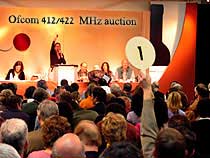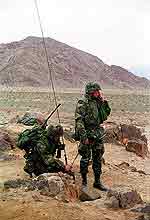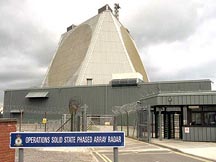Friday 17 February, 2006, 13:34 - Spectrum Management
Ofcom recently organised a seminar concerning the forthcoming auction of a chunk of UHF spectrum covering the UK. The spectrum concerned is 412 - 414 MHz paired with 422 - 424 MHz which was previously the haunt of the UK Ministry of Defence (MoD). The MoD have now (largely) vacated this spectrum and Ofcom has decided that the best use for it is to sell it to the highest bidder along with the rights for the winning bidder to sell it on to whoever they fancy.Four blocks (the inventively named A, B, C and D) of 2 times 500 kHz are being offered, and bidders can bid for one or more of these blocks. The winning bidder(s) will be decided by a complex mathematical calculation to determine which combination of bids yields the maximum revenue to Ofcom.
 By way of an example, let's assume there are four bidders: Eric, Simon, Abby and Tamara. Eric offers GBP300,000 for all four blocks of spectrum. Simon wants 3 blocks and offers GBP200,000 for blocks A, B and C but is not interested in D. Abby wants only 1 block and offers GBP150,000 for any of them - A, B, C or D. Tamara wants two contiguous blocks and offers GBP250,000 for A&B, B&C or C&D. How do we decide the winner? Well in this situation, the maximum revenue that can be generated is if Simon gets blocks A, B and C and Tamara gets block D, yielding revenue of GBP350,000 for Ofcom. If, however, Tamara had only bid GBP100,000 for any block, there would have been a tie. Eric's offer of GBP300,000 for all 4 blocks would tie with a combination of Simon and Tamara's offers.
By way of an example, let's assume there are four bidders: Eric, Simon, Abby and Tamara. Eric offers GBP300,000 for all four blocks of spectrum. Simon wants 3 blocks and offers GBP200,000 for blocks A, B and C but is not interested in D. Abby wants only 1 block and offers GBP150,000 for any of them - A, B, C or D. Tamara wants two contiguous blocks and offers GBP250,000 for A&B, B&C or C&D. How do we decide the winner? Well in this situation, the maximum revenue that can be generated is if Simon gets blocks A, B and C and Tamara gets block D, yielding revenue of GBP350,000 for Ofcom. If, however, Tamara had only bid GBP100,000 for any block, there would have been a tie. Eric's offer of GBP300,000 for all 4 blocks would tie with a combination of Simon and Tamara's offers.The question was asked of Ofcom, "How will you decide between bidders in the event of a tie?" Ofcom's Director of Spectrum Markets, Graham Louth, a well-respected economist replied, "We have a Bingo machine". Highly complex calculations and then a Bingo machine, it's nice to know that UK Government departments use the latest technology, makes you much happier to pay all those juicy taxes.
Let's take a look at the spectrum on offer. In principle it's quite handy. Most modern UHF radios cover the range 400 to 470 MHz and could easily operate in this band. Further, this is one of the main bands in which digital TETRA radios are designed to operate. And if that's not enough, there are even CDMA networks designed to operate in this band. So there's no lack of available equipment. Ofcom are offering the spectrum on a technology neutral basis so any of these technologies could be deployed. Or could they...
 All is not quite as straightforward as it might at first seem. Remember I said earlier that the MoD have now largely vacated this band, well the fact is that there are still around 100 MoD frequency assignments (approximately half of them in Northern Ireland). Details of what and where these assignments are will be accessible to succesful bidders via a software tool that disguises the actual location of usage (for security reasons of course). Further, there are a handful of channels which are used, nationwide, by the MoD. Unless these assignments fall at the very edges of the band (unlikely), there would be insufficient spectrum to deploy cdma2000 which requires a clear block of about 1.5 MHz in order to function. When quizzed about this apparent contradiction to Ofcom's technology neutral stance, Graham Louth responded, "You are misconstruing what we mean by technology neutral". Is that so? cdma2000 can be deployed if you want to, but practically speaking it's impossible to do so. That's like saying, "You can cover this land I'm selling with a building as large as you like, however you mustn't disturb the herb gardens which I've scattered right across it. Oh, by the way, I'm not going to tell you where the herb gardens are until you buy the land".
All is not quite as straightforward as it might at first seem. Remember I said earlier that the MoD have now largely vacated this band, well the fact is that there are still around 100 MoD frequency assignments (approximately half of them in Northern Ireland). Details of what and where these assignments are will be accessible to succesful bidders via a software tool that disguises the actual location of usage (for security reasons of course). Further, there are a handful of channels which are used, nationwide, by the MoD. Unless these assignments fall at the very edges of the band (unlikely), there would be insufficient spectrum to deploy cdma2000 which requires a clear block of about 1.5 MHz in order to function. When quizzed about this apparent contradiction to Ofcom's technology neutral stance, Graham Louth responded, "You are misconstruing what we mean by technology neutral". Is that so? cdma2000 can be deployed if you want to, but practically speaking it's impossible to do so. That's like saying, "You can cover this land I'm selling with a building as large as you like, however you mustn't disturb the herb gardens which I've scattered right across it. Oh, by the way, I'm not going to tell you where the herb gardens are until you buy the land". If that's not bad enough, the RAF Ballistic Missile Early Warning System (BMEWS) radar at Fylingdales in North Yorkshire uses the frequencies from 420 to 450 MHz and so the 422 - 424 MHz block can not be used within the vacinity of this station. The radar, which uses high powered radio transmissions to track incoming missiles, is also likely to cause severe interference over a wide swathe of Northern England. So now as well as the herb gardens, we've got industrial chimneys spewing out pollution over large areas of the land for sale. How come the chimneys don't already pollute the herb gardens, well they're owned by the same person of course - the MoD!
If that's not bad enough, the RAF Ballistic Missile Early Warning System (BMEWS) radar at Fylingdales in North Yorkshire uses the frequencies from 420 to 450 MHz and so the 422 - 424 MHz block can not be used within the vacinity of this station. The radar, which uses high powered radio transmissions to track incoming missiles, is also likely to cause severe interference over a wide swathe of Northern England. So now as well as the herb gardens, we've got industrial chimneys spewing out pollution over large areas of the land for sale. How come the chimneys don't already pollute the herb gardens, well they're owned by the same person of course - the MoD!Most likely someone will want to buy this spectrum; an auction for the same spectrum in the Republic of Ireland raised Euro215,007 for the Irish Government. However with so many holes and so much pollution in it, it will be interesting to see how much, or how little, the auction raises. I'll let you know.
add comment
( 2311 views )
| permalink
| 



 ( 3 / 8867 )
( 3 / 8867 )




 ( 3 / 8867 )
( 3 / 8867 )

